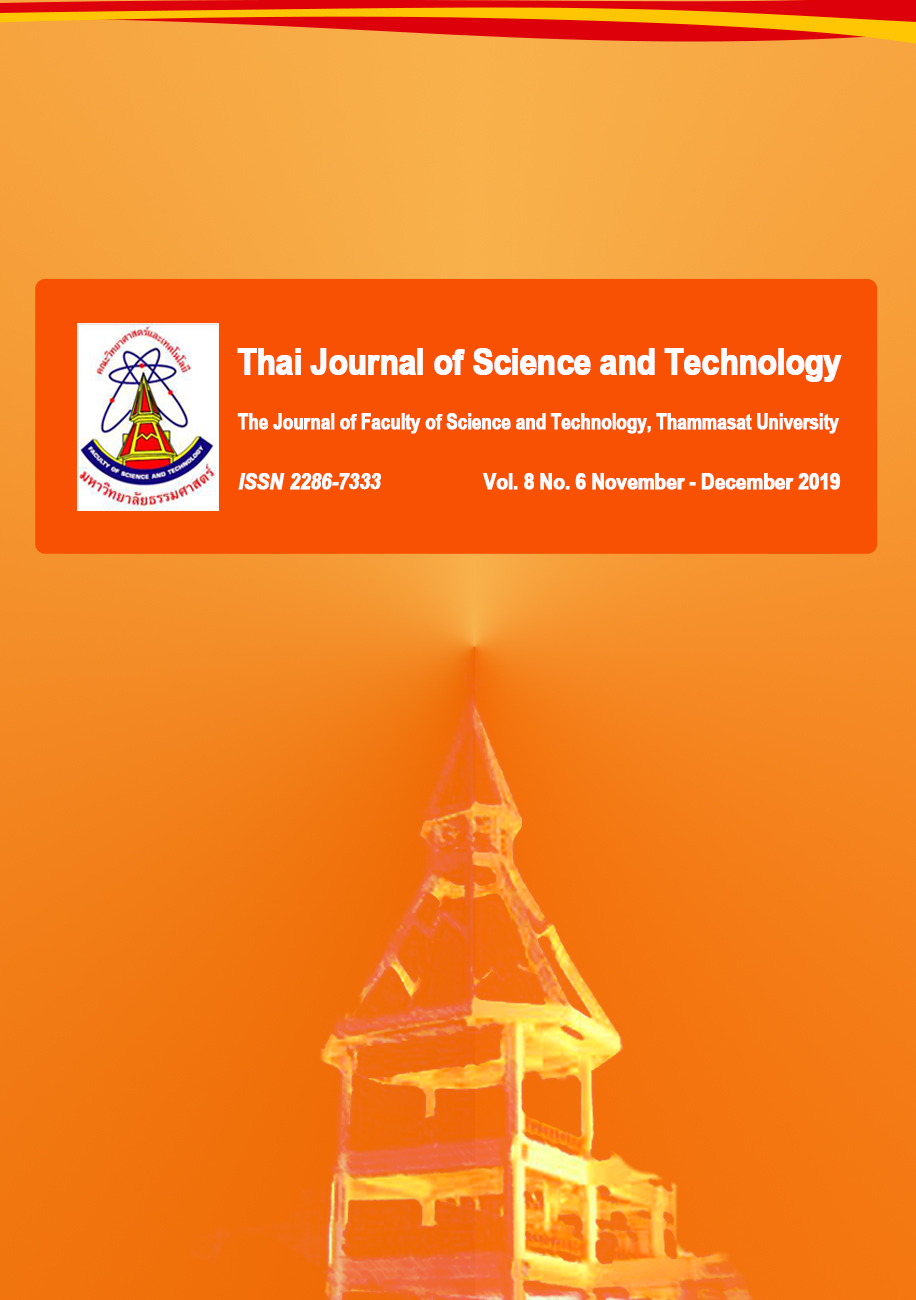ผลของชนิดของอิมัลซิไฟเออร์ต่อคุณลักษณะทางกายภาพของเบต้าแคโรทีนนาโนอิมัลชัน
Main Article Content
Abstract
Abstract
Preparation of β-carotene in nanoemulsion is one of an effective means to improve β-carotene bioactivity and bioavailability. The aim of this study was to investigate the effect of emulsifier types on the physical properties of β-carotene nanoemulsion. To prepare the nanoemulsion, β-carotene was dissolved in rice bran oil (45% w/w) at 60°C under nitrogen gas for 1 h with oil volume fraction of 0.1. Different emulsifiers and their mixtures (3 %) were employed for nanoemulsion fabrication including Tween 80, Span 80, lecithin, β-lactoglobulin (β-Lg), whey protein isolate (WPI), lecithin+Tween 80, lecithin+WPI and Tween 80+Span 80. Emulsion was prepared using a bath sonicator for 10 min followed by a probe sonicator (40 watt and 25 % amplitude) for 10 min. The median droplet size diameter, polydispersity index (PDI), zeta potential, emulsion activity index (EAI), emulsion stability index (ESI) and microstructure of corresponded emulsions were immediately analyzed. The smallest mean particle size diameter (263 nm) was observed in nanoemulsion made by Tween 80 mixed with Span 80. This mixed emulsifier rendered the nanoemulsion with the lowest PDI and distributed more uniform when observed with confocal scanning light microscopy. All emulsions showed the zeta potential lower than -30 mV indicating high stability of these emulsions. The EAI and ESI were higher in proteins-stabilized emulsions. From the results, the β-carotene nanoemulsion was successfully produced by the aid of Tween 80 mixed with Span 80 as an active emulsifier mixture, which exhibited the mean particle size diameter of less than 500 nm.
Keywords: β-carotene; emulsifier; nanoemulsion; physical property
Article Details
บทความที่ได้รับการตีพิมพ์เป็นลิขสิทธิ์ของคณะวิทยาศาสตร์และเทคโนโลยี มหาวิทยาลัยธรรมศาสตร์ ข้อความที่ปรากฏในแต่ละเรื่องของวารสารเล่มนี้เป็นเพียงความเห็นส่วนตัวของผู้เขียน ไม่มีความเกี่ยวข้องกับคณะวิทยาศาสตร์และเทคโนโลยี หรือคณาจารย์ท่านอื่นในมหาวิทยาลัยธรรมศาสตร์ ผู้เขียนต้องยืนยันว่าความรับผิดชอบต่อทุกข้อความที่นำเสนอไว้ในบทความของตน หากมีข้อผิดพลาดหรือความไม่ถูกต้องใด ๆ
References
นิศรา ฮะเจริญ, 2554, การเพิ่มความคงตัวต่อความร้อนในการแปรรูปและความคงตัวต่อความเย็นในการเก็บรักษาของผลิตภัณฑ์กะทิสเตอริไรส์, วิทยานิพนธ์ปริญญาโท, มหาวิทยาลัยศิลปากร, นครปฐม.
ภัทรวรรณ หมกทอง, 2552, ผลของตัวกระทำอิมัลชันผสมต่อเสถียรภาพและประสิทธิภาพในการต้านแบคทีเรียของอิมัลชันน้ำมันกานพลูในน้ำ, วิทยานิพนธ์ปริญญาโท, จุฬาลงกรณ์มหาวิทยาลัย, กรุงเทพฯ.
Ali, A., Mekhlou, G., Huang, N. and Agnely, F., 2016, β-lactoglobulin stabilized nanemul sions – Formulation and process factors affecting droplet size and nanoemulsion stability, Int. J. Pharm. Pharm. Sci. 500: 291-304.
Anandharamakrishnan, C., 2014, Techniques for Nanoencapsulation of Food Ingredients, Springer, New York.
Boon, C.S., McClements, D.J., Weiss, J. and Decker, E.A., 2010, Factors influencing the chemical stability of carotenoids in foods, Crit. Rev. Food Sci. Nutr. 50: 515-532.
Calligaris, S., Plazzotta, S., Valoppi, F. and Anese, M., 2018, Combined high-power ultrasound and high-pressure homogeniza tion nanoemulsification: The effect of energy density, oil content and emulsifier type and content, Food Res. Int. 107: 700-707.
Dickinson, E., 1989, Food colloids – An overview, Colloids Surf. 42: 191-204.
Dziezak, J.D., 1988, Microencapsulation and encapsulation ingredients, Food Technol. 42: 136-151.
Ercelebi, E.A. and Ibanog, E., 2007, Influence of hydrocolloids on phase separation and emulsion properties of whey protein isolate, J. Food Eng. 80: 454-459.
Kaur, K., Kumar, R. and Mehta, S.K., 2016, Formulation of saponin stabilized nano emulsion by ultrasonic method and its role to protect the degradation of quercitin from UV light, Ultrason. Sonochem. 31: 29-38.
López-Castejón, M.L., Bengoechea, C., Espinosa, S. and Carrera, C., 2019, Characterization of prebiotic emulsions stabilized by inulin and β-lactoglobulin, Food Hydrocoll. 87: 382-393.
Lv, G., Wang, F., Cai, W. and Zhang, X., 2014, Characterization of the addition of lipophilic Span 80 to the hydrophilic Tween 80-stabilized emulsions, Colloids Surf. A 447: 8-13.
McClements, D.J., 1999, Food Emulsions. Principles, Practices and Techniques, 4th Ed., CRC Press, Boca Raton, Florida.
McClements, D.J., 2004, Protein-stabilized emulsions, Curr. Opin. Colloid Interface Sci. 9: 305-313.
Pan, Y., Tikekar, R. V. and Nitin, N., 2013, Effect of antioxidant properties of lecithin emulsifier on oxidative stability of encapsulated bioactive compounds, Int. J. Pharm. Pharm. Sci. 450: 129-137.
Pearce, K.N. and Kinsella, J.E., 1978, Emulsifying properties of proteins: evaluation of a turbidimetric technique, J. Agric. Food Chem. 26: 716-723.
Ribeiro, H.S. and Cruz, R.C.D., 2005, Biliquid foams containing carotenoids. Eng. Life Sci. 5: 84-88.
Schramn, L.L., Stasiuk, E.N. and Marangoni, D.G., 2003, Surfactants and their applications, Annu. Rep. Prog. Chem. 99: 3-48.
Sotomayor-Gerding, D., Oomah, B.D., Acevedo, F., Morales, E., Bustamante, M., Shene, C. and Rubilar, M., 2016, High carotenoid bioaccessibility through linseed oil nano emulsions with enhanced physical and oxidative stability, Food Chem. 199: 463-470.
Sui, X., Bi, S., Qi, B., Wang, Z., Zhang, M., Li, Y. and Jiang, L., 2017, Food hydrocolloids impact of ultrasonic treatment on an emulsion system stabilized with soybean protein isolate and lecithin: Its emulsifying property and emulsion stability, Food Hydrocoll. 63: 727-734.
Tabilo-Munizaga, G., Villalobos-Carvajal, R., Herrera-Lavados, C., Moreno-Osorio, L., Jarpa-Parra, M. and Pérez-Won, M., 2019, Physicochemical properties of high-pressure treated lentil protein-based nanoemulsions, LWT Food Sci. Technol. 101: 590-598.
Tan, C.P. and Nakajima, M., 2005, β-Carotene nanodispersions: Preparation, characteriza tion and stability evaluation. Food Chem., 92: 661-671.
Weiss, J., Takhistov, P. and McClements, D.J., 2006, Functional materials in food nano technology, J. Food Sci. 71: 107-116.
Wongsagonsup, R., Shobsngob, S., Oonkhanond, B. and Varavinit, S., 2005, Zeta potential and pasting properties of phosphorylated or cross-linked rice starches, Starch Starke, 57: 32-37.
Yuan, Y., Gao, Y., Zhao, J. and Mao, L., 2008, Characterization and stability evaluation of β-carotene nanoemulsions prepared by high pressure homogenization under various emulsifying conditions, Food Res. Int. 41: 61-68.

